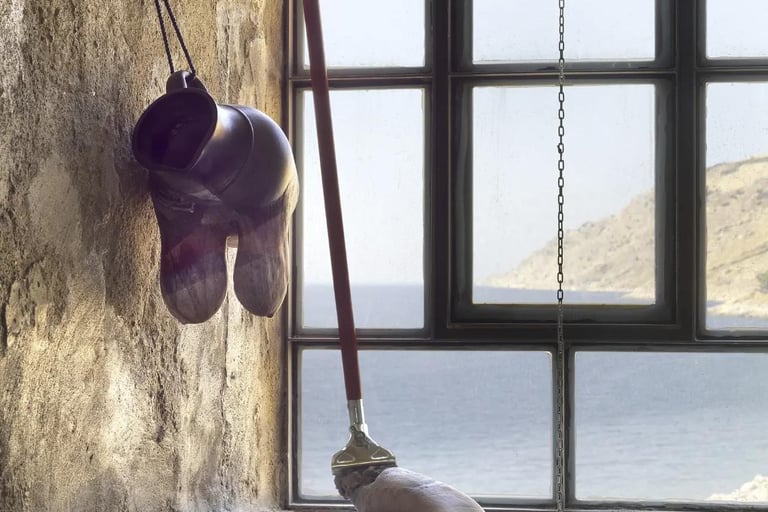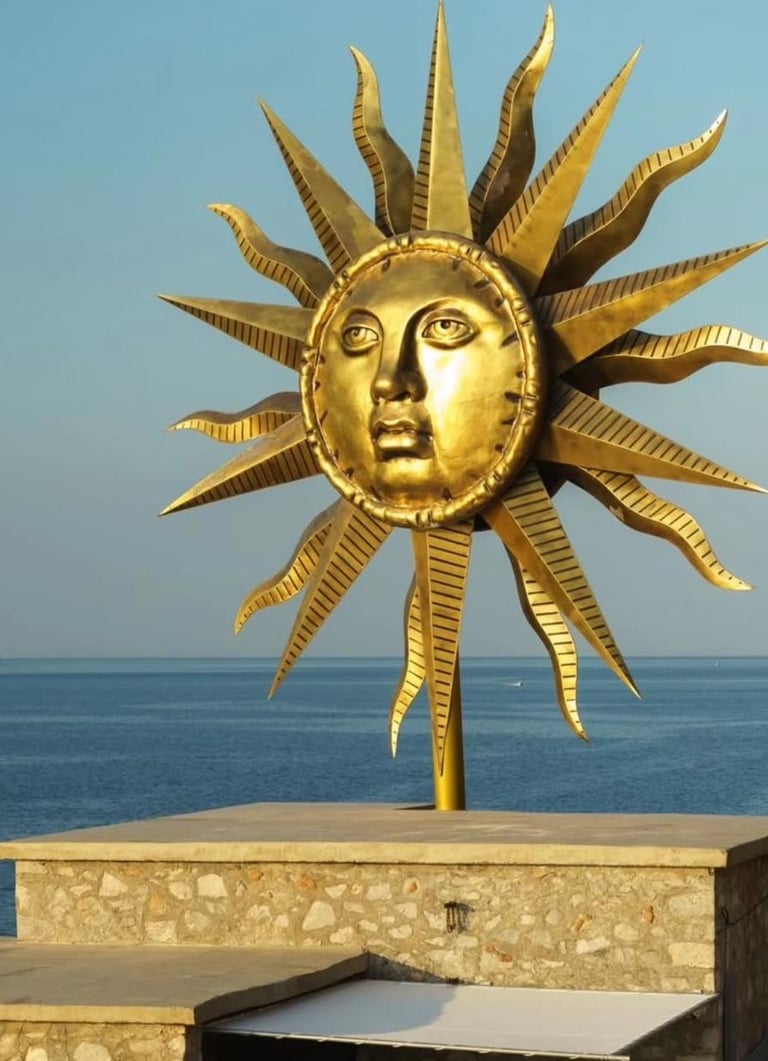Where the Sea Becomes the Stage: The Singular Rite of DESTE Hydra
Perched on Hydra’s rugged cliffs, a former slaughterhouse has become the stage for one of the Mediterranean’s most singular artistic rituals: one exhibition, once a year, where the sea, stone, and light converge to shape works that cannot exist anywhere else. From Koons’ solar myth to Ursuța’s apocalyptic visions, DESTE Hydra is not just a space—it’s a pilgrimage, a laboratory, and a lesson in how place, time, and art can fuse into pure intensity.
TODAY'S HEADLINER
Charlotte Madeleine CASTELLI
8/13/20254 min read


The Seaside Laboratory Where Art Becomes a Summer Rite
Perched on the rocky cliffs of Hydra, suspended between salt and Mediterranean light, a former municipal slaughterhouse has been transformed into one of the most influential stages for contemporary art. Since 2009, the DESTE Project Space Slaughterhouse has hosted a single intervention each summer, inviting artists to engage with a severe, almost ascetic architecture and the breath of the sea: a secular liturgy, once a year, that has redefined the Mediterranean’s site-specific imaginary. The space was granted to the Foundation by the Municipality in 2008, and since then has become a cornerstone of the Greek art season.
The slaughterhouse—exposed stone, minimal interiors, an opening to the horizon—functions as a threshold device: forcing both works and audiences into a physical confrontation with the landscape, removing art from the white cube and exposing it to light, wind, and salt spray. It is a “right place in the wrong place”: the functional memory (sacrifice, the blood once flowing to the sea) remains as an undercurrent that intensifies perception. Every intervention here is inherently situated and temporal: open from June to October, it marks the season with a single authorial voice, transforming Hydra into an annual pilgrimage for artists, curators, and collectors.
2025 — Andra Ursuța, Apocalypse Now and Then
For 2025, Andra Ursuța deploys a sculptural language that confronts vulnerability, superstition, and post-socialist memories as an archaeology of the present. Apocalypse Now and Then (June 24–October 31, 2025) is her first major solo show in Greece: a theatre of bodies and relics that, step by step, disarms and rekindles the relationship between ruin and desire. The slaughterhouse’s darkness and slivers of light become dramaturgy; the work emerges as an intermittent oracle, questioning our suspended time.


2024 — George Condo, The Mad and the Lonely
In 2024, George Condo inhabited the Slaughterhouse with a chorus of fractured figures, between masks and psyche: an atlas of “congenital solitudes” which, against the open marine backdrop, resonated like a score of necessary dissonances. On view from June 18 to October 31, 2024, the installation transformed the architecture into a mental stage, reaffirming the venue’s vocation to catalyse emotional tension in the form of apparition.
2022 — Jeff Koons, Apollo
With Jeff Koons (2022), the space embraced a solar rite: the monumental Apollo Wind Spinner towered over the entrance like a rotating star, while inside, the over 2.3-metre Apollo Kithara animatronic played the echo of a pop classicism, merging citation and technology. Walls clad with motifs inspired by the Boscoreale frescoes multiplied the interplay between archaeology and visual consumption. Hydra became a planetarium of contemporary myth.


2017 — Kara Walker, Figa
Among the most powerful presences, Kara Walker introduced Figa in 2017, a monumental fragment from her project A Subtlety (Domino Sugar Factory, 2014): a clenched fist with the thumb between the index and middle fingers—both apotropaic gesture and provocation—recast into Hydra’s symbolic geography. In the slaughterhouse context, the work amplified Walker’s discourse on race, power, and wounded iconographies, turning the landscape into a political counterpoint.
2018 — David Shrigley, Laughterhouse
With David Shrigley, the ironic shift in register was literal: from “slaughter” to “laughter,” balancing black humour with disarming graphic simplicity. An episode that confirmed the programme’s freedom of tone, able to move from allegorical density to the immediacy of the absurd.
The Hydra ritual is not an island unto itself: it is part of an ecosystem that each June connects Athens with the Saronic archipelago, becoming a key stop on the international calendar after Art Basel. The DESTE Weekend convenes global communities and local practices, forging relationships, sustaining production, and stimulating reflection in a compressed but highly charged timeframe. In doing so, a former peripheral infrastructure becomes a pulsating centre, reshaping the geographies and tempos of art.
Hydra stands as a model of how curatorship can be rooted in a strong territorial identity and a sustainable format: a single annual exhibition, born from a site-specific commission that prioritises duration, research, and lived experience over the frenzy of constant programming. Within this framework, the dialogue between memory and technology takes centre stage: from Koons’ “augmented” classicism to the psycho-political allegories of Condo and Walker, through to Ursuța’s apocalyptic sculpture, Hydra emerges as a laboratory where tradition, the politics of the body, and technical imagination intertwine without lapsing into nostalgia. This alchemy has produced not only a living archive of radical interventions but also a high-quality cultural tourism ecosystem, attracting a transnational community that experiences the space as a liturgy of encounter.
This convergence of curatorial rigour, experimentation, and community offers Future a valuable lesson in developing immersive and participatory cultural districts. DESTE Hydra is a case study in territorial curatorship: form coincides with place, the calendar with the climate, the work with the landscape. Each edition adds a chapter to a narrative that does not exhaust itself within the exhibition, but endures as cultural geology: layers of interventions deposited in the memory of the site and in the perception of those who return, year after year, to “see”—as the Foundation’s name itself suggests. For Future, observing Hydra is to learn how minimal architecture and a precise temporal framework can generate maximum aesthetic and public intensity.
© Charlotte Madeleine Castelli | All rights reserved
